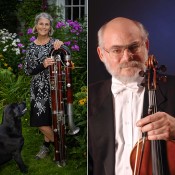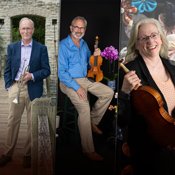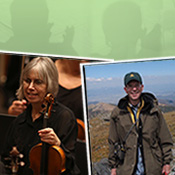
MSO Retiree Spotlight: Glenn Asch and Mary Terranova
David Lewellen
PUBLISHED
Tagged Under: 2024.25 Season, MSO Musicians, Violin
Two retirees from the Milwaukee Symphony’s second violin section this year have new musical adventures awaiting them.
The season-ending concerts in June will conclude the tenures of Glenn Asch, who joined the MSO in 1980, and Mary Terranova, who arrived in 1990. For most of his career, Asch has had an active sideline of playing violin in jazz, rock, and bluegrass groups, and he plans to do more once he has more free time. But Terranova has an entirely new challenge waiting for her — the viola da gamba.
Her curiosity was piqued by retired MSO cellist Kathy Collisson, a longtime enthusiast of the Baroque instrument that resembles a cello. “Everything’s going to be new to me, except treble clef,” Terranova said. “I enjoy playing music I’ve never heard of.”
After 35 years in the second violin section, new music has become rarer, but playing the same pieces again has its own challenges. Terranova said that the orchestra librarians will usually erase the notes that she writes in her part, so when it comes back a few years later, “I just re-learn it. I ask myself what’s the best way.”
Although the entire section uses the same bowing, individual violinists are free to come up with their own fingerings, and Terranova said that the person sitting in the outside position on the stand (closer to the audience) writes above the staff, and the person on the inside position writes below the staff.
She has sat both outside and inside since the symphony began using rotating seating some years ago. “It’s healthy for everyone to have new stand partners,” she said. “Some people have fingerings I want to copy; some people bring out something I hadn’t heard before. And some people have good jokes.”
Looking back over her time in the MSO, she cited the move to the Bradley Symphony Center as a highlight. For the orchestra’s entire history, it has dreamed of having its own hall, she said, and “I felt so lucky to be able to experience that. It’s a beautiful space, a very warm sound, and we have a nice lounge and space to practice.” She also looks back fondly on playing at the Green Bay Packers game and touring the state of Wisconsin.
Glenn Asch, too, remembers the state tours, which used to be longer and more frequent. Whether it was Wisconsin or Europe or Japan, he said, “experiences like that pull an orchestra together in a unique way. Performing the same repertoire in different halls brings an orchestra up a level.”
In the 1980s, he said, players from within the string sections got the opportunity to solo with the orchestra on tour, and he performed the complete Brahms violin concerto three times. He also drew on his knowledge of other genres to do jazz and fiddle arrangements for MSO performances.
In retirement, he will have more time for groups like Triple Crown, which plays American roots music, and the jazz band Holton’s Heroes. He and his wife, Laurie, also perform Senegalese music with African musicians at Club Timbuktu in the Riverwest neighborhood.
“I just turned 70, and I feel I can’t wait much longer to do justice to my other creative impulses,” Asch said. In addition to performing, he also composes and arranges for the groups that he works with. Some of his other bandmates don’t read written music and perform strictly by ear, and Asch feels fortunate that he can think both ways. On the classical side, he wrote a full-length violin concerto years ago, which he performed with several regional orchestras.
Asch attended Kewaskum High School, UW-Madison, and UW-Milwaukee before winning his MSO audition in 1980. His father, Albert “Bud” Asch, taught at UW-Washington County and founded the Kettle Moraine Symphony in 1968, with Glenn Asch and his siblings anchoring four of the string sections.
“Music is music, like food is food,” he said. “I like all kinds of food and all kinds of music, and I can skip from one to the other.” Creating music on the spot is a completely different way of thinking from today’s classical tradition, he said. “It’s very liberating, and it’s kept me enthusiastic about orchestral playing.”



